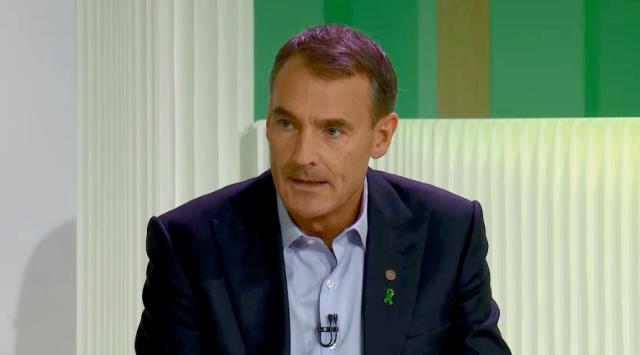
New BP CEO Bernard Looney lays out the company's 2050 net-zero goals. (Source: Mary Holcomb, Hart Energy/ BP Plc)
BP Plc pledged to meet net-zero carbon emissions by 2050, as incoming CEO Bernard Looney on Feb. 12 outlined his focus on a greener, reimagined shift to clean energy.
“The biggest challenge for BP is the one that the world is facing: climate change,” Looney said during his introductory webcast. His presentation comes a week after climate change protestors forced BP to temporarily close its London headquarters, during Looney’s first days in office.
“The world’s carbon budget is finite and running out fast; we need a rapid transition to net-zero,” he said. “To deliver that, trillions of dollars will need to be invested in replumbing and rewiring the world’s energy system. It will require nothing short of reimagining energy as we know it.”
The plan includes cutting its greenhouse gas emissions from its operations worldwide—which is around 55 million tonnes of CO2 equivalent per year with roughly 360 million tonnes of CO2 equivalent per year from its oil and gas production—on an absolute basis. Collectively, the company intends to reduce 425 million tonnes of emissions made yearly to net-zero by 2050.
“This is what we mean by making BP net-zero,” he said. “It directly addresses all the carbon we get out of the ground as well as all the greenhouse gases we emit from our operations. These will be absolute reductions, which is what the world needs. If this were to happen to every barrel of oil and gas produced, the emissions problem for our sector would be solved.”
So what implications do these new initiatives have on BP’s oil and gas business?
Looney revealed BP’s existing upstream and downstream segments will dismantle and reorganize into one integrated entity. The new structure, he said, will focus more broadly on energy.
To that development, Looney intends to increase capital into low-carbon businesses and less in oil and gas over time. The company’s production volumes, he specified, will decline gradually and the remaining hydrocarbons will be decarbonized through carbon capture techniques.
Looney did not clarify whether declining its oil and gas business would require selling assets or cutting dividends, but said he will monitor BP’s portfolio to make those decisions moving forward. He noted, however, that BP’s exploration budget was down 66% prior to today’s announcement.
BP will still focus on driving cash, returns, and margins, but with the aim of creating the “highest quality portfolio” as opposed to chasing prices with more investment which he said is costly and “doesn’t end very well,” Looney said.
Additionally, he said the company will stick to some of its fundamentals to ensure it is still “performing while transforming.” BP plans to deliver on its investor commitments on capital discipline to maintain its shareholders’ trust, grow free cash flow and shareholder distributions and generate competitive returns.
Moreover, the company’s net-zero aim also includes cutting the carbon intensity of the products it sells by 2050 or sooner, and installing methane measurements at all of its major processing sites by 2023 and leveraging the data to further cut emissions.
However, Warwick Business School Professor David Elmes argued BP’s new plan neglects the emissions from products sold to its customers.
“Today, BP firmly joins the group of energy companies that are setting themselves goals to be net zero by 2050,” Elmes said in a statement. “However, when companies set goals, you need to check the details. For energy companies, that means including both the emissions from their activities to find, produce, and sell energy with the emissions produced when that energy is used by their customers. So what BP emits in producing and selling petrol, but also the emissions when you use that petrol in your car.”
BP has also vowed to lobby for policies that support the transition even steering away and removing advertisements from its Possibilities Everywhere campaign.
The presentation on Feb. 12 outlined a rather distant and foggy journey, but Looney said BP will host a capital markets day in September to give out better details on its clean energy initiatives.
Recommended Reading
Chevron Adds to Carbon Capture Tech Portfolio with ION Investment
2024-04-04 - Chevron New Energies led a funding round that raised $45 million in Series A financing for ION Clean Energy, according to a news release.
enCore Energy Appoints Robert Willette as Chief Legal Officer
2024-02-01 - enCore Energy’s new chief legal officer Robert Willette has over 29 years of corporate legal experience.
SunPower Appoints Garzolini as Executive VP, Chief Revenue Officer
2024-03-14 - Tony Garzolini will oversee SunPower’s sales, including the direct, dealer and new homes channels, along with pricing and demand generation.
Baker Hughes Awarded Saudi Pipeline Technology Contract
2024-04-23 - Baker Hughes will supply centrifugal compressors for Saudi Arabia’s new pipeline system, which aims to increase gas distribution across the kingdom and reduce carbon emissions
NOV's AI, Edge Offerings Find Traction—Despite Crowded Field
2024-02-02 - NOV’s CEO Clay Williams is bullish on the company’s digital future, highlighting value-driven adoption of tech by customers.





